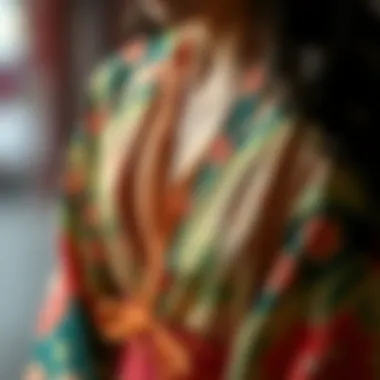Exploring the Allure of Kimono Lingerie


Intro
The world of lingerie has evolved significantly over the years, blending cultural heritage with modern sensibilities. Among the myriad styles available today, kimono lingerie stands out as a unique and captivating choice. Originating from traditional Japanese garments, kimono lingerie introduces an exquisite alliance of craftsmanship and contemporary fashion. These lovely pieces, often designed with intricate patterns and luxurious materials, offer more than just aesthetic appeal; they also embody a deep-rooted cultural significance.
Kimono lingerie can be seen as a canvas where the ancient artistry of Japan meets the innovations of modern lingerie design. This exploration not only honors the traditions that have shaped this garment but also emphasizes how it adapts to contemporary tastes and styles. In this article, we will dissect the elements that make kimono lingerie a popular pick for many, delving into its history, styling tips, and care practices.
Get ready to travel through time as we traverse the path of kimono lingerie, discovering its evolution, the emotions it evokes, and the practicality it offers in today’s fast-paced world. By the end, readers will grasp the importance and intricacies of kimono lingerie, whether they are fashion designers looking for inspiration, retailers seeking unique offerings, or simply enthusiasts wanting to embrace this striking garment.
Preamble to Kimono Lingerie
The exploration of kimono lingerie provides a fascinating entry point into both fashion and cultural history. It brings together the delicate intricacies of traditional Japanese garments with modern sensibilities, allowing a broader audience to appreciate the beauty and narrative embedded in such designs. More than just a functional item, kimono lingerie embodies a lifestyle choice and reflects one's understanding of aesthetics in personal attire.
Diving into kimono lingerie is like peeling an onion; each layer reveals nuances of art, history, and personal expression. At its core, it challenges preconceived notions of lingerie by revisiting and revitalizing the kimono, a garment steeped in centuries of Japanese art and tradition. While typically associated with intimacy, lingerie here also becomes a narrative that emphasizes grace and sophistication, translating ancient art into contemporary wear.
One important aspect to consider is the influence of cultural significance on the designs and materials chosen. Different fabrics contribute to the feel and presentation of kimono lingerie, influencing choices based on season, occasion, and personal comfort. Without delving into the cultural heritage that informs these designs, one risks losing the essence that makes kimono lingerie distinctive.
In this article, we will unpack the layers of this intriguing subject via definitions, cultural significance in Japan, historical context, and the modern reinterpretations of these garments. The aim is to provide a comprehensive overview that enables designers, stylists, and marketers to appreciate the deeper meanings behind kimono lingerie and its relevance in today’s fashion scene.
"Kimono lingerie challenges our understanding of what intimate wear is by combining traditional artistry with modern funk."
As we move forward, let’s first define kimono lingerie itself to set the stage for deeper exploration.
Historical Background
Understanding the historical context of kimono lingerie is essential for grasping its contemporary significance. The interplay of tradition and innovation has shaped this unique garment, resulting in a versatile piece that transcends mere fashion. In exploring the origins and evolution of kimono lingerie, one can appreciate how societal shifts, cultural exchange, and technological advancements have influenced its design and function.
The Evolution of the Kimono
The kimono, with its rich lineage, can be traced back to the Heian period (794-1185), serving as an attire for nobility and commoners alike. Initially, it was more than just clothing; it was a canvas showcasing Japanese artistry through intricate designs and vibrant fabrics. As centuries passed, the kimono transformed—not only in style but also in its societal implications. The garments evolved from the layered jūnihitoe, a multi-layer kimono worn by aristocratic women, to more simplified forms accessible to a broader audience.
As Japan entered the Meiji era (1868-1912) and modernized, Western influences began to creep into traditional styles. This led to the fusion of Western lingerie elements with the traditional kimono silhouette. The global interactions during this time influenced fabric choices and construction techniques, leading to varied styles of kimono lingerie today. It encapsulates a melding of cultures, where satin and lace meet traditional silk and cotton.
Even in the post-World War II period, the kimono underwent substantial change. With the rise of casual wear, the kimono was adapted into different forms, including lingerie, marking a pivotal point in its evolution. Kimono lingerie has grown to embody comfort alongside elegance, appealing to modern sensibilities while respecting its roots.
Lingerie Trends Through the Ages
Lingerie, as we know it today, has its origins steeped heavily in history. The transformation of undergarments has mirrored changing social norms—where once they were purely functional, they became a symbol of femininity and allure. In the late 19th and early 20th centuries, corsets dominated, constraining the feminine form and embodying the Victorian ethos. The liberation movement of the 1960s and 70s then marked a radical shift, leading to embrace of comfort and practicality in lingerie design.
By the late 20th century, designs started becoming more diverse. Variations began flooding the market, blending styles from around the world—including the elegant grace of kimono influences.
Kimono lingerie emerged as a segment in this evolving landscape. It offers a balance of sexiness and comfort, appealing to those looking for delicate yet functional pieces. The current trends emphasize versatility, allowing individuals to wear them not just as intimate apparel, but as fashionable attire.
Design Elements of Kimono Lingerie
The design elements of kimono lingerie play a crucial role in its distinctiveness, bridging the gap between traditional Japanese aesthetics and contemporary sensuality. It's not just about the garment itself; it’s about how each aspect—from fabric choices to patterns—works in harmony to reflect cultural heritage while appealing to modern sensibilities. Understanding these design elements allows fashion designers, retailers, and enthusiasts to appreciate the craftsmanship involved and the significance it holds in today’s fashion narrative.


Fabric Choices
The type of fabric used in kimono lingerie is pivotal to its overall aesthetic and comfort. Traditionally, silk has been the fabric of choice, celebrated for its lustrous finish and smooth texture. This luxury fabric conveys elegance and sophistication, making the wearer feel special. However, modern iterations may incorporate various materials like cotton, chiffon, or even lace, as designers explore diverse tactile experiences and visual effects.
- Silk: Often selected for its rich histories, it maintains a cultural link.
- Cotton: Provides comfort while offering breathability and ease of care.
- Chiffon: Adds a layer of floatiness, creating an ethereal quality.
- Lace: Brings in a romantic flair, enhancing femininity and allure.
The choice of fabric can determine not only how the garment fits but also how it drapes and moves. This dynamic attribute affects the wearer’s comfort and confidence, influencing the emotional experience of donning a kimono-inspired ensemble.
Traditional Patterns and Motifs
Traditional Japanese patterns carry layers of meaning and history, often depicting elements from nature, like cherry blossoms or waves. These motifs are not merely decorative; they tell stories and evoke emotions tied to specific cultural narratives. In the context of kimono lingerie, these patterns are reimagined, marrying heritage with contemporary aesthetics.
Some of the commonly used motifs include:
- Asanoha (hemp leaf): Symbolizing growth and resilience.
- Seigaiha (blue ocean waves): Representing peace and tranquility.
- Kiku (chrysanthemum): A symbol of perfection and longevity.
By selecting certain patterns, designers can imbue their pieces with cultural significance while appealing to a global audience looking for authenticity in their fashion choices. This blending of traditional motifs with modern designs highlights the versatility of kimono lingerie, making it suitable for various occasions from intimate settings to stylish loungewear.
Modern Versus Traditional Styles
The distinction between modern and traditional styles in kimono lingerie is an intriguing conversation point. Traditional styles emphasize structure and form, drawing on the simple yet elegant lines of the classic kimono. In contrast, modern interpretations often prioritize comfort, fluidity, and individuality, allowing wearers to express their unique personalities.
- Traditional Styles: Feature longer sleeves and an intricate sash (obi). These garments adhere closely to historical designs, often evoking a sense of nostalgia.
- Modern Styles: Tend to incorporate shorter cuts, unconventional fabrics, and innovative closure systems. Designers may blend traditional elements with contemporary silhouettes, resulting in hybrid pieces that resonate with today's fashion landscape.
The interplay between old and new empowers wearers to navigate their fashion choices with freedom, enabling them to celebrate cultural roots while adapting to modern lifestyles and preferences. This evolution marks kimono lingerie as not just a functional garment but a narrative of cultural adaptation and creativity.
The wheels of fashion are always turning, and understanding the design elements of kimono lingerie offers a glimpse into a world where tradition and modernity coexist beautifully.
Styling Kimono Lingerie
When it comes to kimono lingerie, the way one styles this unique garment can make all the difference. Styling isn’t just about layering pieces carelessly on top of each other; it’s an art form that intertwines cultural nuances and contemporary trends. The essence of styling kimono lingerie lies in its ability to highlight not only the intricate beauty of the garment but also to enhance the wearer's personality.
Layering Techniques
Layering remains a central tenet when it comes to wearing kimono lingerie fashionably. One notable technique is to combine the kimono with complementary pieces that offer both comfort and visual appeal. For instance, a kimono robe can be beautifully accented with a sleek, fitted bodysuit underneath. This setup balances the generous flow of the kimono with the more tailored silhouette of the bodysuit, creating an oh-so-flattering outline.
Another popular trick involves choosing colors that speak to each other. For example, pairing a pastel-colored kimono with contrasting dark base layers can add depth. Mixing patterns is also an exciting option. If the kimono features floral designs, consider wearing solid or subtler prints beneath to avoid a clash while still making a statement.
“Layering is not just about adding more—it's about creating a harmonious visual narrative.”
Essential tips for effective layering include:
- Choose the Right Fabrics: Opt for breathable materials to ensure comfort, especially if layers are piled on.
- Vary Lengths: Incorporating pieces of varying lengths, like a cropped top beneath a longer kimono, can add intrigue.
- Think About Proportions: Balance is key; a voluminous kimono paired with a tighter fit allows for an effortless yet structured look.
Accessorizing for Impact


Accessorizing kimono lingerie can further elevate the aesthetic and create unique looks for different occasions. The choice of accessories should complement the kimono while reflecting personal style. A statement belt can cinch the waist of the kimono, pulling the whole outfit together and adding an hourglass silhouette. Wide-brimmed hats and oversized sunglasses can effortlessly add a touch of glamour, making the wearer feel runway-ready.
Jewelry also plays a pivotal role in completing the look. Opt for minimalist pieces to keep attention on the kimono’s intricate patterns. Long pendant necklaces can add vertical lines to the outfit, enhancing its flow. For those looking to inject a splash of color, bold earrings in contrasting shades can transform the overall vibe.
Crucial accessorizing points include:
- Balance Statement Pieces: If the kimono is loud, keep accessories subtle and vice versa.
- Layering Accessories: Stack soft bracelets for a bohemian look, allowing the fabric of the kimono to shine.
- Footwear Choices: Heeled sandals or stylish mules can add allure, while comfortable flats provide ease without compromising style.
Whether you favor traditional styling methods or wish to incorporate modern flair, effective layering and attention to accessories can significantly enhance the kimono lingerie experience, ensuring that it's not just an outfit but a statement of identity.
Kimono Lingerie in Modern Fashion
Kimono lingerie has carved out a distinctive niche in the contemporary fashion landscape. Combining traditional Japanese craftsmanship with modern aesthetics, it offers a unique lens through which to explore the evolving definitions of sensuality and elegance. This blend not only showcases historical artistry but also emphasizes the importance of cultural respect and sustainability in today’s fashion industry.
Celebrity and Runway Influences
In recent years, kimono lingerie has garnered significant attention on the runways and among celebrities. Fashion icons like Rihanna and Kendall Jenner have been seen donning outfits that incorporate kimono-inspired elements, sparking interest among followers and fans alike. Such figures, as arbiters of style, play an essential role in elevating the visibility of kimono lingerie in mainstream culture.
This surge in celebrity interest has driven a wave of design innovations, encouraging designers to explore the versatility of kimono fabrics and patterns in unique ways.
Several fashion labels now feature collections that embrace kimono lingerie, merging traditional textiles with contemporary design. This movement is not simply about aesthetics; it's also a statement about cultural appreciation. It invokes a conversation around the importance of preserving the beauty of traditional garments while still allowing for creative reinvention.
Global Appeal and Market Trends
The fascination with kimono lingerie is not confined to Japan. Its appeal has transcended borders, resonating with consumers around the globe. A growing number of fashion enthusiasts are drawn to the flowing lines and intricate patterns that characterize these garments, as they offer a breath of fresh air compared to conventional lingerie.
Market trends indicate a significant uptick in demand for ethically sourced and culturally inspired clothing. As global awareness about sustainability increases, consumers are more inclined to support brands that showcase responsible practices. Kimono lingerie, with its emphasis on artisanal craftsmanship and respect for heritage, neatly aligns with these values.
Consider the rise of boutique shops that specialize in this offering. Many now source materials from local artisans in Japan, supporting traditional weaving techniques and providing a story behind each piece. As a result:
- Consumer Interest: Shoppers are more interested in garments that not only look good but also have depth and history.
- Brand Collaborations: High-profile collaborations between Western designers and Japanese craftspeople have become more frequent, leading to a dynamic exchange of ideas.
- E-commerce Growth: Online platforms have made it easier for niche brands to reach a broader audience, further fueling the trend.
As kimono lingerie continues its journey in modern fashion, it emerges as both a style statement and a cultural dialogue. The interplay between tradition and modernity ensures its relevance in a fast-changing fashion landscape.
Sustainability in Kimono Lingerie
Sustainability is a pressing topic in fashion today, particularly in the realm of lingerie where consumption patterns often clash with ethical considerations. The importance of sustainability in kimono lingerie cannot be overstated, as it brings together the rich tapestry of Japanese tradition and modern ecological awareness. As designers and consumers increasingly prioritize responsible practices, kimono lingerie stands at the crossroads of heritage and innovation.
The incorporation of sustainable practices extends well beyond just the choice of fabrics. It permeates the entire supply chain—from design and manufacturing to packaging and distribution. By emphasizing eco-friendly processes, such as reducing waste and utilizing local artisans, brands can preserve the unique craftsmanship of kimono lingerie while also minimizing their environmental footprint.
Ethically Sourced Materials
A key component in the sustainability conversation is the use of ethically sourced materials. Traditional kimono fabrics, like silk, can be produced in a way that respects both environmental and social standards. For instance, some brands are now opting for organic cotton or bamboo fibers, which not only reduce reliance on harmful chemicals but also support sustainable agricultural practices.
- Organic Cotton: Grown without synthetic pesticides, this fabric is kinder to both the land it’s grown on and the people working on it.
- Bamboo Fibers: Naturally antibacterial and biodegradable, bamboo is an ideal choice for lingerie that needs to be both soft and sustainable.
- Upcycled Textiles: Some designers are creatively reusing or repurposing materials from old kimonos, giving a second life to what might otherwise go to waste.


The use of such materials often translates into not just less environmental damage but also a unique story embedded in each piece. As consumers, knowing that a garment comes from an ethical background adds a layer of appreciation and connection to the richness of kimono culture.
Impact of Fast Fashion
Fast fashion presents a significant challenge to sustainability in the realm of kimono lingerie. The rapid turnaround of trends leads to an unsustainable production cycle that often disregards craftsmanship and quality in favor of quicker, cheaper alternatives. As a result, many traditional techniques and styles risk being overshadowed by mass-produced items that lack genuine cultural significance.
"When you compromise on time-honored practices for the sake of speed, you lose not just quality, but the very fabric of the culture itself."
The environmental impact of fast fashion is drastic; from greenhouse gas emissions to excessive water usage and pollution, the fashion industry often leaves a heavy mark. Consumers have the power to combat this by choosing kimono lingerie that is designed for longevity rather than obsolescence. Here’s what you can do:
- Invest in Quality: A well-crafted kimono lingerie piece may cost more initially but typically lasts much longer.
- Support Local Artisans: Purchasing from small businesses not only bolsters local economies but also keeps traditional skills alive.
- Educate Yourself: Understanding the processes behind each piece enhances your appreciation and encourages more sustainable choices.
Care and Maintenance
Taking care of your kimono lingerie is crucial not just for preservation but also for enhancing its beauty and longevity. These delicate garments often blend intricate fabrics and designs that deserve thoughtful attention. Practicing proper maintenance can ensure that the rich colors and refined details remain vibrant and intact over time. More than just a matter of routine care, understanding how to properly clean and store these pieces reflects appreciation for their craftsmanship and historical significance.
Cleaning Instructions
When it comes to cleaning kimono lingerie, a gentle touch goes a long way. Here are some instructions to keep your pieces in top shape:
- Hand washing is best: Fill a basin with cool water and a mild detergent. Avoid harsh chemicals or bleach, as these can damage the fabric and fading the intricate patterns.
- Soak, don’t scrub: Allow the garments to soak in the soapy water for about 10-15 minutes. Gently agitate the water, but avoid vigorous scrubbing. It’s all about being tender with these fabrics.
- Rinse thoroughly: After soaking, drain the soapy water and refill the basin with clean water. Rinse the lingerie until all soap residue is gone. Be careful not to wring or twist the fabric, as this may distort the shape.
- Air drying: Lay your kimono lingerie flat on a clean towel or a drying rack. Direct sunlight can fade the colors, so it is best to dry them in a shaded area, allowing air circulation to do the work.
Taking the time to properly clean your kimono lingerie not only keeps it looking fresh but also honors the legacy of the garment itself.
Storage Tips for Longevity
How you store kimono lingerie plays an integral role in its lifespan. Here are some tips to keep your cherished pieces in pristine condition:
- Use breathable fabric bags: Instead of plastic, opt for cotton or silk bags to shield your lingerie from dust while allowing the fabric to breathe.
- Avoid folding: If possible, hang your kimono lingerie on padded hangers to prevent creases. If folding is necessary, use acid-free tissue paper to cushion the folds and avoid sharp creases.
- Keep away from light: Store in a dark area to protect against fading. Consider a dedicated drawer or a dark closet to shield these garments from direct sunlight.
- Regular checks: Every season, take a moment to inspect your pieces. This can help catch potential issues, like pests or changes in fabric that may require attention before it becomes a larger problem.
"Proper care extends the life of your lingerie and preserves its beauty, reflecting your appreciation for traditional craftsmanship."
By incorporating these cleaning and storage practices, you ensure that your kimono lingerie remains as captivating as the day you saw it. Embracing this approach means you respect not only the piece itself but the cultural narrative it carries along with it.
Finale
The finale of our exploration into kimono lingerie wraps up a journey through the intricate blend of cultural heritage and modern fashion trends. This section underscores the pivotal role kimono lingerie plays not only in the realm of aesthetics but also as a statement piece reflecting broader societal shifts in body positivity and fashion articulated through a rich lineage of design.
The Enduring Allure of Kimono Lingerie
Kimono lingerie stands as a beacon of what happens when tradition meets modernity. Its charm lies in the delicate balance it strikes; the graceful lines and silky fabrics evoke a soft nostalgia while embracing contemporary elegance. This duality captivates a diverse audience—from fashionistas drawn to its unique style to those cherishing the cultural roots embedded within its fabric.
A notable aspect is that kimono lingerie often speaks to individual identity. Many wearers find a sense of empowerment in garments that are rich in story and artistic expression. Traditional motifs like crane or cherry blossom not only exhibit breathtaking beauty but also symbolize various significances in Japanese culture. This is particularly attractive to consumers looking for more than just clothing but a wearable piece of art that connects them to a lineage steeped in history.
Future Trends and Innovations
Looking ahead, the fusion of technology and design in kimono lingerie is more than likely to influence the market. Fabric innovations, such as the utilization of sustainable textiles, are gaining momentum. Designers are increasingly exploring eco-friendly materials without compromising comfort or allure. As awareness around sustainability grows, consumers are much more inclined to support brands that harmonize beautiful design with ethical production practices.
Moreover, the embracing of diverse body types in fashion will push kimono lingerie into new territories. Expect to see designs crafted not solely for the traditional silhouette but tailored to flatter an array of body shapes, enhancing inclusivity.
While the future is anything but set in stone, the trajectory suggests a melding of traditional aesthetics with forward-thinking designs that both honor the past and welcome the new. A direct consequence of this evolution could be the expansion of interest and appreciation for kimono lingerie among global audiences, leading to a richer dialogue on its cultural implications.















